How To Freeze Citrus – 3 Ways!
Learn how to freeze citrus (lemons, limes, and oranges) so you’ll always have some on hand. It’s quick, easy, and a great way to avoid food waste.

If you’ve ever wondered about how to freeze citrus, look no further! We’ve got a generous neighbor with a lemon tree and have also made the mistake of buying a big bag of limes from Costco (maybe more than once).
As you may already know, an abundance of fresh citrus will last for a few weeks in the fridge. But not forever.
So we’ve gotten pretty good at freezing the extras. That way we’ve always got a lemon to liven up roasted broccoli and limes to make a batch of peanut lime sauce for two or squeeze over a pair of yummy spaghetti squash burrito bowls.
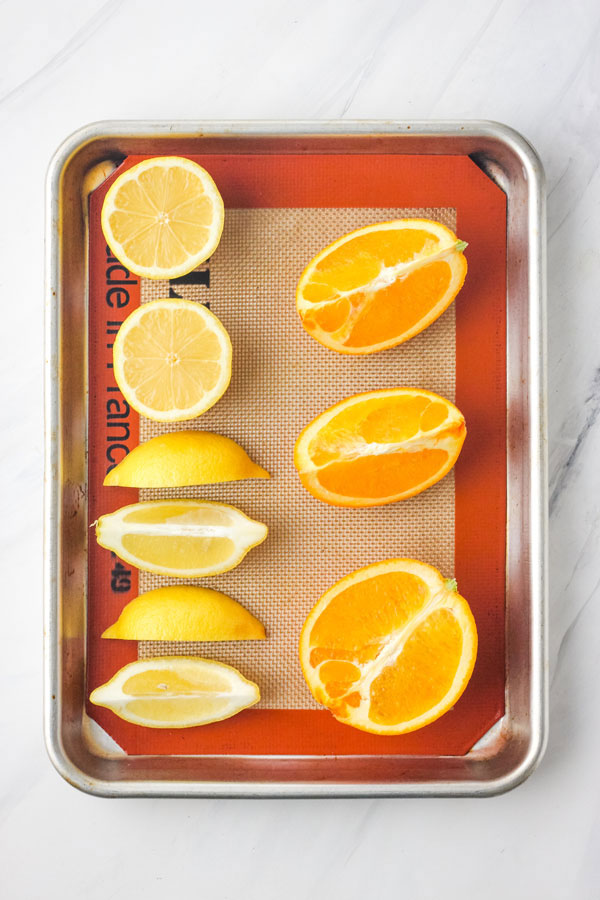
When it comes to freezing citrus there are a few options.
- You can freeze it whole, sliced in half, or in wedges.
- If freezer space is a concern, you can also freeze the zest and juice into easy-to-store ice cubes.
Regardless of which method we use, we always start with washing and drying the fruit.
How to Freeze Whole Citrus
Place the washed and dried citrus in a freezer-safe bag. Press out all the air and seal the bag. Add to your freezer.
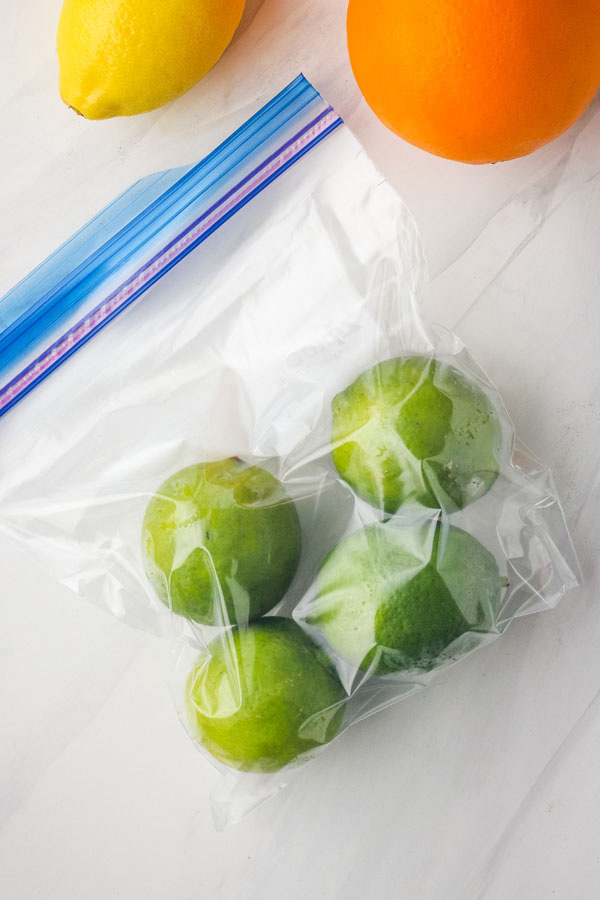
To use:
- Remove the amount you plan to use (ie. one lime) from the bag.
- I like to zest it after it’s thawed for a few minutes but still semi-frozen. Once totally thawed it’s squishier and harder to zest or grate the peel.
- To juice, let the citrus come to room temperature on the counter or microwave for 10 to 15 seconds (lemons and limes only!). Then slice in half and juice.
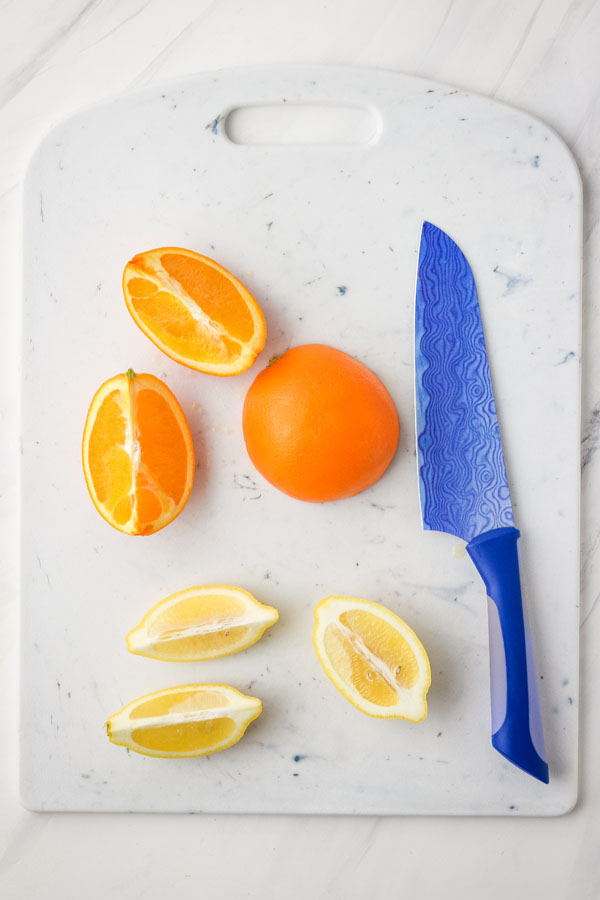
Halves and Wedges
We like to add frozen wedges to drinks instead of ice cubes. They keep iced tea or water nice and cool without watering it down and they look pretty too.
Plus as the wedges slowly defrost they add a nice lemony flavor.
If most of your recipes only need a tablespoon of juice, grabbing half a lemon or orange might be more convenient.
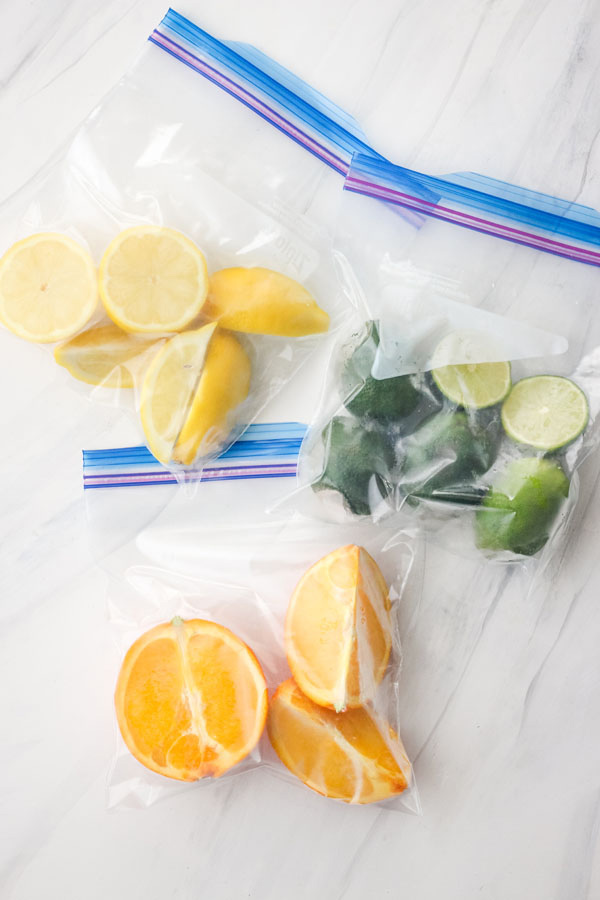
If you just toss a bunch of fresh wedges and halves together in a bag they’ll stick together as they freeze. To prevent that from happening, we freeze them on a baking sheet before bagging.
How to freeze halves and wedges:
- Line a pan with a silicone mat or parchment paper.
- Slice the citrus as desired, place it on the pan, and add it to a flat shelf in the freezer.
- Once the citrus has frozen solid (about 2 to 3 hours), place the wedges/halves in a freezer-safe bag. Press out the air, close the bag, and return it to the freezer.
Freezing Citrus Juice Cubes
This method is a little more work up-front but it makes adding citrus to any dish a snap. Plus the cubes take up less space in your freezer.
Kitchen Tools Needed
- Sharp Knife
- Empty Ice Cube Tray(s)
- Tablespoon Measuring Spoon
- Measuring Cup or Glass with a pourable spout
- Cheese grater with small holes or a micro-zester
Useful (but not necessary) Gadgets:
Last Christmas we received an awesome citrus juicer that does both lemons and limes! We use it so much it’s now my favorite housewarming gift to give, everyone loves getting one.
Now, before you get to squeezing and freezing, you’ll want to figure out how many tablespoons each cube in the tray holds. This is important if you plan to use the cubes in future recipes.
We have two sets of ice cube trays. One that holds 1 tablespoon of liquid and one that holds 2 tablespoons.
The easiest way to determine how much your tray will hold is to measure 1 tablespoon of water and pour it into one empty cube in the tray.
If it fills to the top you have your answer. If there is still plenty of room try pouring in another tablespoon of water.
Once you know the amount it’s time to get down to business.
How To Freeze Extra Lime Juice
- Start by zesting all of the limes.
- Put 1/4 teaspoon of zest into the bottom of each individual cube in the tray.
- Slice and juice all of the limes into the measuring cup or glass.
- Carefully pour the juice into the tray making sure to cover the zest.
- Place the filled tray in the freezer and freeze until the cubes are solid.
If you don’t have other plans for the trays (and the available space in your freezer) you can leave the cubes in them and pop them out as needed.
Otherwise, store the cubes in a plastic freezer-style bag. Bonus points if you label the bag with how many tablespoons of juice are in each cube!
Using The Cubes In A Recipe
If you’re baking a recipe, defrost the cubes before adding them to your batter.
For soups and blender salsa we just toss the cubes right into the pot or food processor (this is where knowing how much juice is in a cube can be super helpful).
You can also use this method to freeze the juice and zest for extra lemons and oranges too.
Troubleshooting
Occasionally we’ll have a few cubes stick to the tray (especially with orange juice). If that happens, carefully pop them out with a butter knife or offset spatula. Dipping the bottom of the tray in warm water for a few seconds will also cause the cubes to release.
We try our best to use up any frozen citrus within 2-3 months of freezing. After that, the whole citrus, halves, and wedges tend to dry out and don’t taste as good. The cubes do seem to hold up a little better.
More Helpful How-Tos
- How to Store Fresh Herbs So They Last Longer
- How to Air Fry With a Convection Toaster Oven
- 29 Cooking Tips and Tricks for Smaller Households
- How to Measure Half an Egg
- How to Make Small Batch Whipped Cream
- How to Freeze Canned Pumpkin Puree
- How to Make Half a Cake Mix
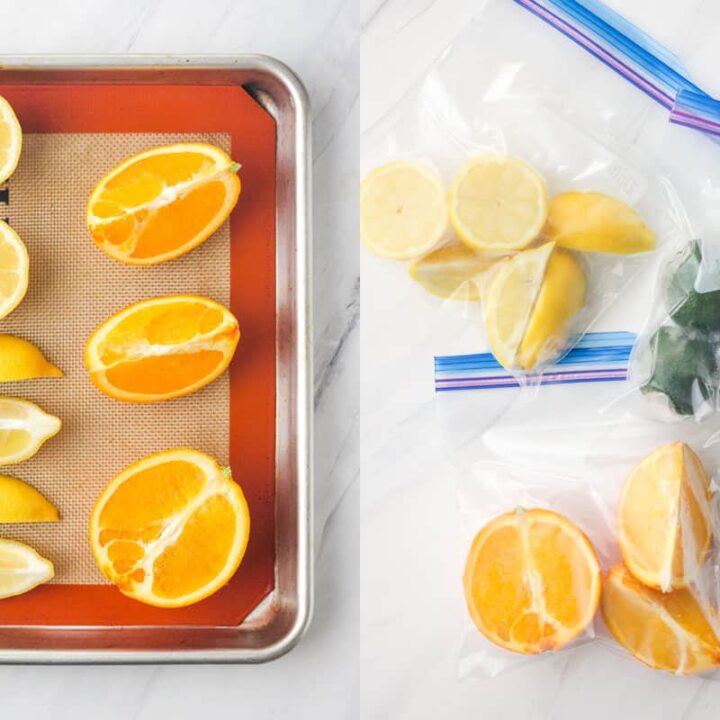
How To Freeze Citrus (3 Ways)
The directions below are for freezing limes but you can also use this method to freeze lemons, oranges, and other citrus.
Ingredients
- Fresh Limes, washed and dried well
Instructions
How To Freeze Whole Citrus
- Place the washed and dried limes in a freezer-safe bag. Press the air out, seal the bag, and add to the freezer.
- When ready to use, remove the desired amount from the freezer. Thaw for a few hours in the fridge or on the counter. *Frozen lemons and limes can be microwaved for 10 to 15 seconds to speed things up but use caution and do not microwave whole oranges.
How To Freeze Halves and Wedges
- Line a baking sheet with a silicone mat, parchment paper, or waxed paper.
- Slice the limes as desired and place the pieces on the prepared pan. Freeze for 2 to 3 hours.
- Remove the frozen halves or wedges and place them in a freezer-safe bag.
- Press the air out of the bag, seal it, and store in the freezer.
How To Freeze Lime Juice Cubes
- Zest the limes (if desired), and place a little into the bottom of each cavity of an ice cube tray.
- Squeeze the juice into a measuring cup or glass and carefully pour it into the ice cube tray. If using zest, make sure the juice is covering all of it.
- Place the filled tray in the freezer and freeze until the cubes are solid (about 3 hours). *For a more stable surface, place the tray on a baking sheet in the freezer.
- Once frozen, pop out the cubes and transfer them to a freezer-safe bag.
Notes
Sticky Juice Cubes: Dip the bottom of the tray in warm water for a few seconds and the cubes should release. If they are very stubborn, try carefully loosening the edges of the cubes using a butter knife or mini-offset spatula.
Texture: The frozen oranges will be squishy when defrosted. This makes them great for juicing but not for eating like you would when fresh.
Use By Suggestions: Sliced and whole frozen citrus is best if used within 2-3 months of freezing. After that, they will start to dry out and won’t taste as good. Stored properly, our frozen juice cubes seem to hold up a little better, about 3 to 6 months.
Nutrition Information:
Yield: 1 Serving Size: 1 LimeAmount Per Serving: Calories: 30

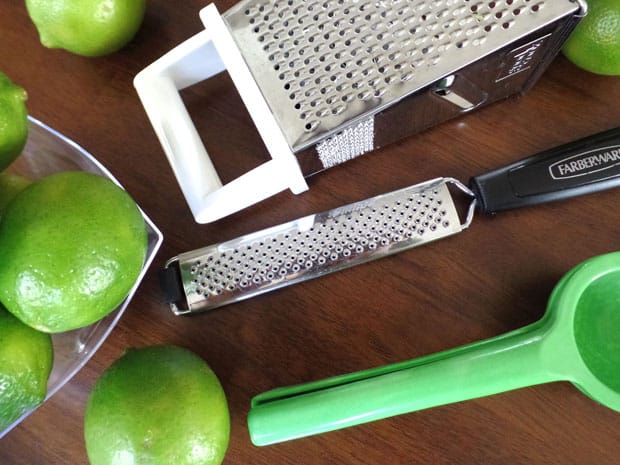
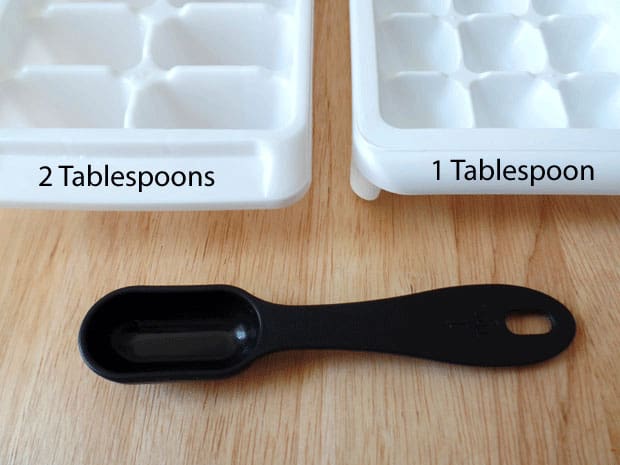
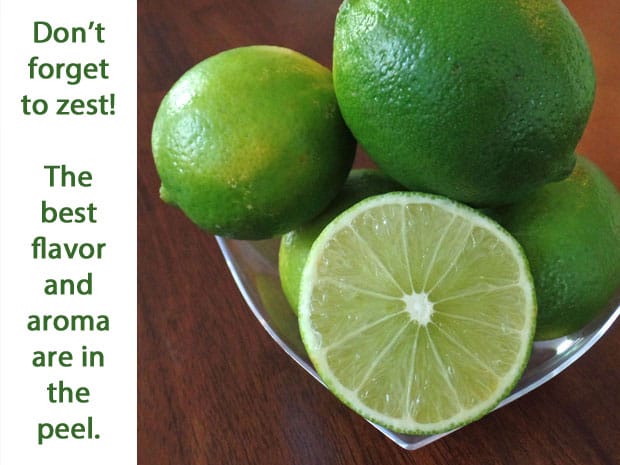
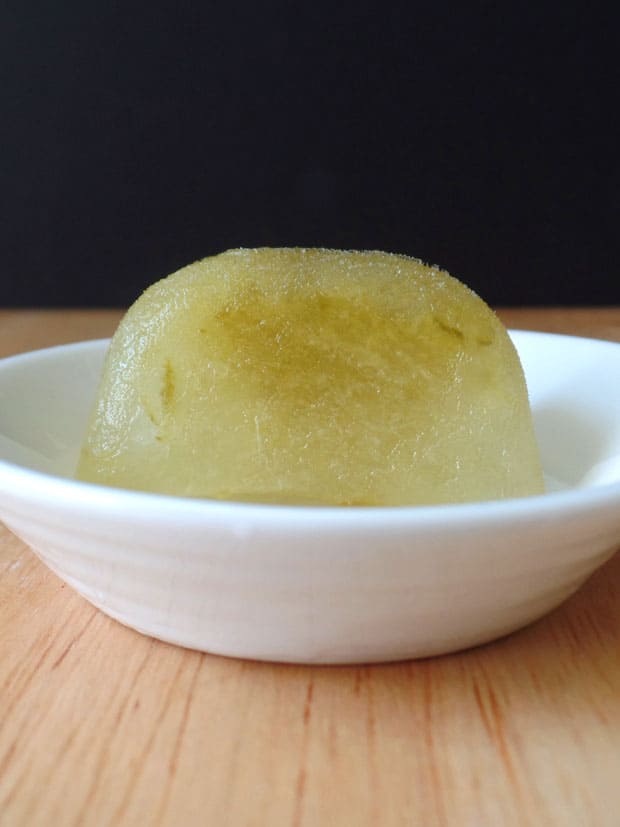
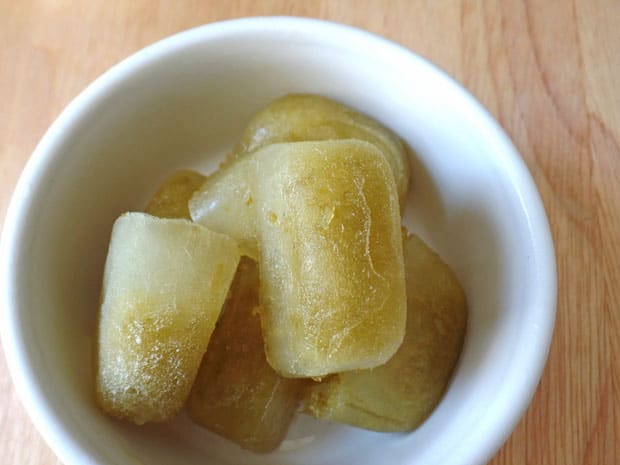
Which juicer did you get? I’ve tried a couple and am not happy.
Hi Cheryl,
My current citrus squeezer was a gift and has a label of ChefsGrade but I don’t think it’s available anymore.
What I like about it is that it’s coated metal and has separate spots for juicing lemons and limes. Looking online, the Zulay Kitchen Metal 2-in-1 Lemon Squeezer appears very similar.
One thing I’d recommend if you go with a coated metal one is to handwash only. We’ve never put ours in the dishwasher and the coating has held up well for years.
1- Why do we need to place lemon zest at the bottom of the cube tray?
2- Is it safe to freeze citrus juice in a silicon, PVC free, BPA free ice cube tray?
Hi Sara,
You don’t have to add the zest in the cubes. We like to add it because the skin/zest contains a lot of great flavors. If it’s not your thing, you can just leave it out.
Re the trays, we haven’t had any trouble freezing all kinds of things from lime juice to leftover tomato sauce or pesto in our super basic ice cube trays. But I’m not a manufacturer so I can’t speak to the safety of any product. If you’re worried about it, I’d check with the manufacturer of your trays to be sure.
Thanks for posting I have an entire case of limes to use and freeze! Any more tips would be great!
Hi Cindy,
If you’re short on freezer space, I’d go with mostly the lime cubes – they’re very easy to stack and store. Also, you can freeze the juice in measuring cups if you want to save it in larger quantities like 1/2 or 1/4 cup.
To use up some of the fresh ones you could make a few giftable recipes like lime curd, preserved limes, or homemade margarita mix. Popsicles are another great way to use up a lot of lime juice.
Hope that helped and that you have lots of tasty fun making your way through the case 🙂
Thank you! Super helpful before my 6 limes go bad!
Yay, Barbara! So glad we could help 🙂